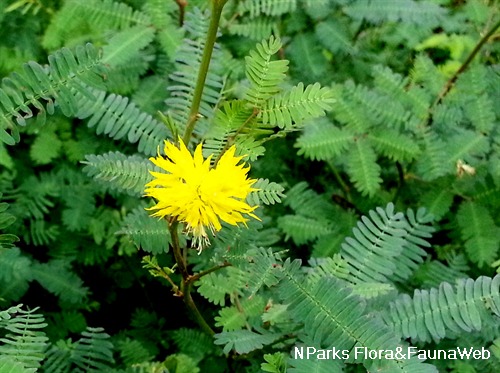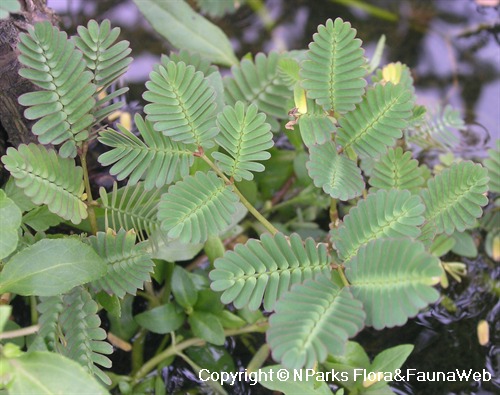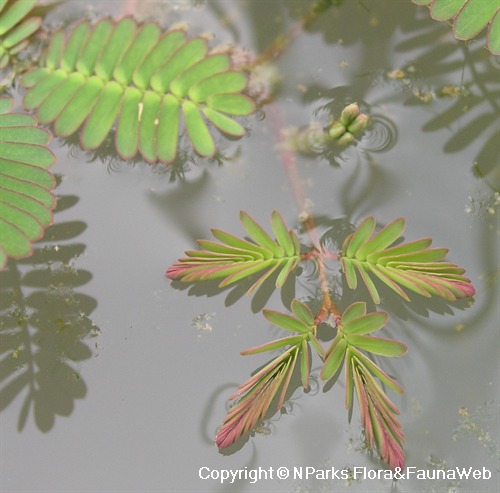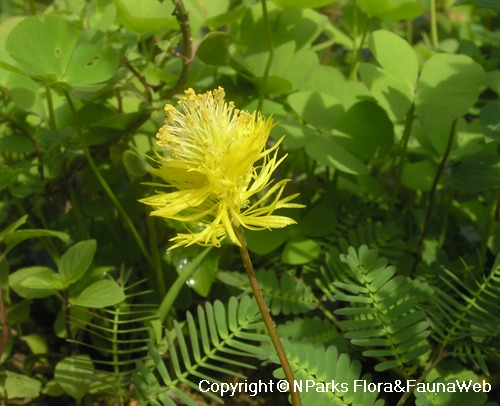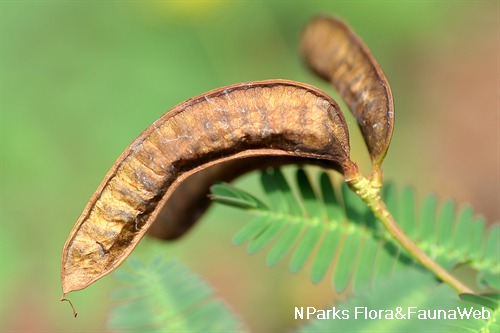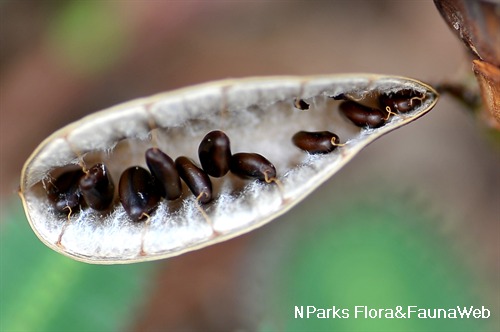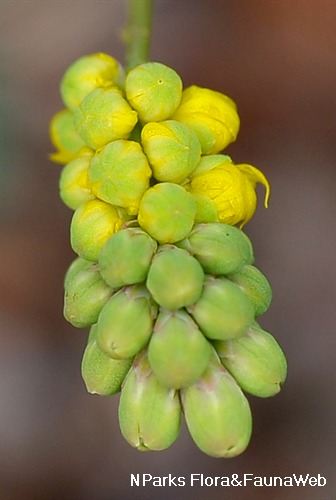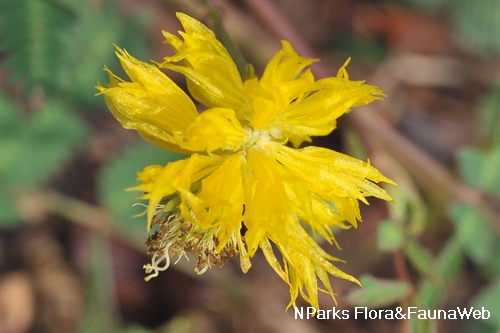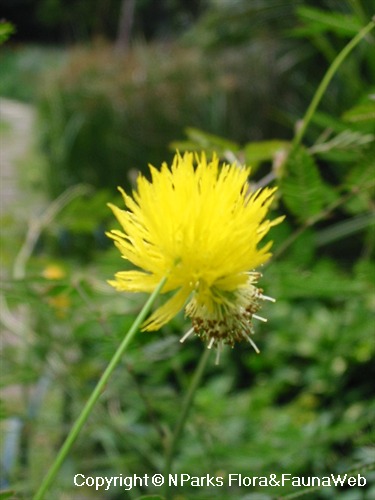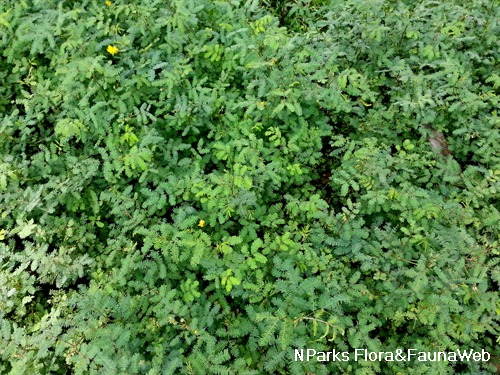
Back
Neptunia oleracea Lour.
| Family Name: | Fabaceae (Leguminosae) |
| Synonyms: | Neptunia prostrata, Neptunia natans |
| Common Name: | Water Sensitive Plant, Water Mimosa |
Name
Classifications and Characteristics
| Plant Division | Angiosperms (Flowering Seed Plants) (Dicotyledon) |
|---|---|
| Plant Growth Form | Aquatic & Hydrophyte (Emergent Aquatic), Creeper |
| Mode of Nutrition | Autotrophic |
Biogeography
| Native Distribution | Tropical Asia, Africa and South America. |
|---|---|
| Native Habitat | Aquatic (Freshwater Pond / Lake / River) |
| Preferred Climate Zone | Tropical |
| Local Conservation Status | Non-native (Spontaneous (Naturalised)) |
Description and Ethnobotany
| Growth Form | A perennial aquatic herb that is sometimes grown as an annual, it can grow as a floating plant or prostrate near the water’s edge. In its rooted land form, the plant has smaller leaves and flowers, with no spongy floating tissue. |
|---|---|
| Roots | N. olearacea possesses a thick taproot that becomes woody. |
| Foliage | Leaves green, alternate and bipinnate with petioles 2-7 cm long. |
| Stems | Stems terete (= like a slender, tapering cylinder, more or less circular in any cross-section), growing up to 1.5 m long and rarely branched. They become detached from the primary root system, with spongy-fibrous tissue (for floating) and fibrous adventitious roots forming at the internodes, when growing in water. |
| Flowers | Inflorescence a solitary axillary spike (= inflorescence with sessile flowers) that may be erect or slightly nodding, the peduncle (= the stalk of the inflorescence). Flowers are small and sessile (= not stalked), sterile ones on the lower part of the inflorescence and bisexual ones on the upper part. Calyx bell-shaped and corolla consisting of five free yellow petals. |
| Fruit | Fruit a legume, green when unripe and brown when mature, splitting along both sides and contains 4-8 seeds that are brown in colour. |
| Others - Plant Morphology | Widely distributed in both the northern and southern tropical regions, the origin of Neptunia oleracea is uncertain. It occurs both wild and cultivated as a vegetable in Southeast Asia, especially in Thailand and Indo-China. |
| Habitat | Commonly found growing in and around fresh water ponds, swamps and canals at low altitudes up to 300 m, perishing with decreasing water levels. |
| Cultivation | N. oleracea prefers shallow depths (30-80 cm) of slow-moving water, full sun and hot and humid conditions and is adversely affected by shade, brackish water and saline soil. In Thailand, cultivation of the plant begins during the rainy season (May) and flowering starts during the dry season (December), with cropping lasting 4-6 months.N. olearacea may be propagated by seed, but more conventionally by stem cutting.Diseases to which N. olearacea is subsceptible has not been recorded, with few pests attacking the plant. However, the stem and spongy tissue of the plant may be attacked by the larvae of the leaf roller (Synclita species). Plant-eating fishes, turtles, ducks and geese have been found to feed on N. olearacea. |
| Etymology | Neptunia, the genus name, means “of the seas”, for Neptunus, the Greek god of the seas. The specific epithet “oleracea means “of cultivation, aromatic, esculent, vegetable”. |
| Ethnobotanical Uses | Edible Plant Parts : Edible Leaves Food (Fruit or Vegetable): N. olearacea is a nutritious vegetable. In Thailand, where N. oleracea is a common ingredient of Thai cuisine, the plant is cultivated mainly for its young shoots, which are eaten as a raw, cooked or fried vegetable. (Herb or Spice) Medicinal: The roots and juice from the stems are used in Malaysia as traditional remedies to treat conditions, including earache, syphilis and necrosis of the bones of the nose. |
Landscaping Features
| Desirable Plant Features | Ornamental Foliage |
|---|---|
| Landscape Uses | Riverine |
Plant Care and Propagation
| Light Preference | Full Sun |
|---|---|
| Water Preference | Lots of Water |
| Plant Growth Rate | Fast |
| Rootzone Tolerance | Waterlogged Soils (Drains Site) |
| Propagation Method | Stem Cutting |
Foliar
| Mature Foliage Colour(s) | Green |
|---|---|
| Prominent Young Flush Colour(s) | Pink |
Floral (Angiosperm)
| Flower Colour(s) | Yellow / Golden |
|---|
References
| References | Siemonsma, J.S. and Piluek, K. (Editors). 1994. Plant Resources of South-East Asia (PROSEA) No 8. Vegetables. Bogor, Indonesia: Prosea Foundation. |
|---|
Image Repository
Others
| Master ID | 30535 |
|---|---|
| Species ID | 4844 |
| Flora Disclaimer | The information in this website has been compiled from reliable sources, such as reference works on medicinal plants. It is not a substitute for medical advice or treatment and NParks does not purport to provide any medical advice. Readers should always consult his/her physician before using or consuming a plant for medicinal purposes. |

